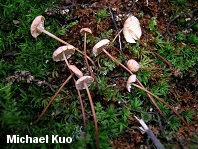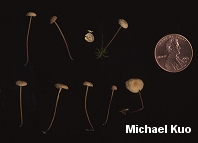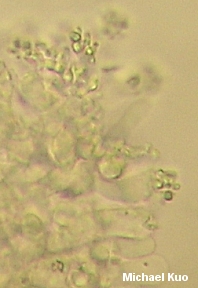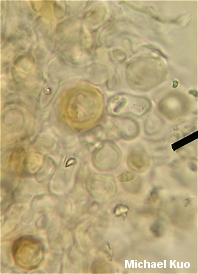| Major Groups > Gilled Mushrooms > Pale-Spored > Marasmioid > Mycetinis scorodonius |

|
Mycetinis scorodonius [ Basidiomycetes > Agaricales > Marasmiaceae > Mycetinis . . . ] by Michael Kuo Lots of mushrooms have peculiar and distinctive odors but this little guy, along with a couple of his close relatives, reeks of garlic and onions--so much so, in fact, that you can sometimes smell the tiny little things in the woods before you see them. Usually, odors in tiny mushrooms are faint until you crush a cap between your thumb and finger, but this routine isn't needed with Mycetinis scorodonius. Either that, or the few collections I have made were particularly pungent. The "Marasmius scorodonius" in your field guide is, indeed, the same little stinker of a mushroom as the one illustrated here. A study from 2005 (Wilson & Desjardin) determined that several of our traditional generic concepts for marasmioid and collybioid mushrooms were not supported by DNA; the garlicky species of Marasmius, the authors determined, belonged with several other species in Mycetinis. A 1998 study (Gordon & Petersen) determined the North American version of Mycetinis scorodonius was able to mate with the European version; thus a single biological species is found on either side of the Atlantic. Other garlic-reeking species in North America include Mycetinis copelandii and Mycentinis olidus, both of which differ from Mycetinis scorodonius in having hairy to velvety stems and spores that are longer than 10 µ; the former is found in western North America and the latter is found east of the Rocky Mountains. Description: Ecology: Saprobic; primarily found on the fallen needles of conifers, but occasionally found on the mossy bark of living hardwoods or conifers, or arising from grass stems or twigs (of hardwoods or conifers) in woodland settings; growing scattered or gregariously; summer and fall; widely distributed east of the Great Plains; absent or very rare in the west. Cap: 2-30 mm across; convex, becoming broadly convex or broadly bell-shaped but often developing a central depression and/or bump; dry; bald; becoming slightly wrinkled; medium brown when very young but soon fading to buff or pale tan, with or without a slightly darker center. Gills: Narrowly attached to the stem, or rarely attached to a tiny "collar" that circles the stem; whitish; close or nearly distant. Stem: Up to 60 mm long; 0.5-3 mm thick; equal; dry; shiny; bald, or with a few tiny hairs near the base; whitish to pale tan, becoming reddish to dark reddish brown by degrees from the base up. Flesh: Thin; insubstantial. Odor and Taste: Strongly of garlic or onion. Spore Print: White. Microscopic Features: Spores 6-10 x 3-5 µ; smooth; pip-shaped or ellipsoid; inamyloid. Pleurocystidia absent. Cheilocystidia to about 40 x 11 µ;; more or less clavate to cylindric, or irregular; often lobed; covered with knoblike or rodlike projections. Pileipellis a hymeniform layer of subglobose to clavate or irregular cells that sometimes develop fingerlike projections. REFERENCES: (Fries, 1815) A. W. Wilson & Desjardin, 2005. (Fries, 1821; Saccardo, 1887; Kauffman, 1918; Gilliam, 1975; Smith, Smith & Weber, 1979; Desjardin, 1987; Doyle & Sundberg, 1989; Breitenbach & Krânzlin, 1991; Phillips, 1991/2005; Lincoff, 1992; Gordon & Petersen, 1998; McNeil, 2006; Miller & Miller, 2006.) Herb. Kuo 07030805. This site contains no information about the edibility or toxicity of mushrooms. |
© MushroomExpert.Com |
|
Cite this page as: Kuo, M. (2013, January). Mycetinis scorodonius. Retrieved from the MushroomExpert.Com Web site: http://www.mushroomexpert.com/mycetinis_scorodonius.html |



